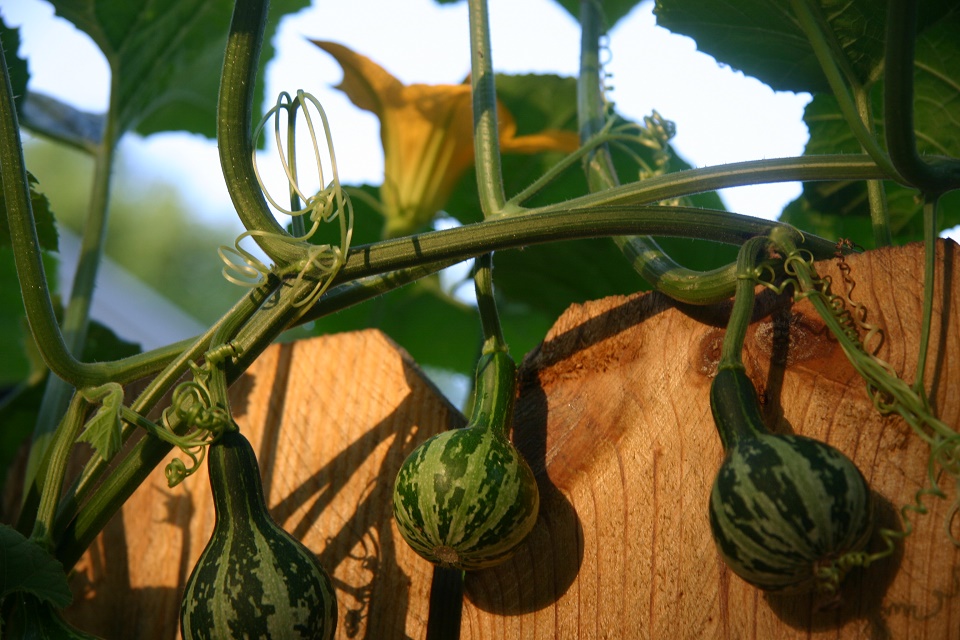
A Native and Heirloom that Will Dance Its Way into Your Heart
Updated July 25, 2017, to clarify the use of pyrethrin (also known as pyrethrum insecticide)
From the UT Gardens
July 2017 Plant of the Month: Tennessee Dancing Gourd
Submitted by Amy Dismukes, UT/TSU Extension, Williamson County
My first introduction to the Tennessee Dancing Gourd was a few years back at the Williamson County Fair, when a Master Gardener submitted a tiny, green and white cutie for judging in the fruit and vegetable competition. With just one glance I knew I was in for trouble. I had to have it if only to satisfy my infatuation with heirloom plants.
When thinking of the gourd plant, we immediately envision the typical bottle-type variety most recognizable in its birdhouse form. There are many others, however, that tend to be overlooked, if only because they’re not commercially available by seed or hard to find. This would be the case with the Tennessee Dancing Gourd (TDG).
TDG (Cucurbita pepo var. ovifera), also known as the Tennessee Spinner, is an heirloom variety and a member of the cucurbit family. It’s grown annually from seed. At one time, seeds became almost impossible to find, leaving many a gourd enthusiast to believe this gem may have disappeared for good.
There’s very little known about the TDG other than it originated from a Mr. Gordon of Primm Springs in Hickman County, Tennessee, and its popularity was high with children. These tiny treasures provided hours of entertainment as they can be spun just like a top. It’s said that many a playground would be littered with these tiny treats after lunch because kids would carry them in their pockets to play with at school.
Cultivation tips for TDG are similar to others in the family. Plant in warm soil, whether starting with seed or seedling. Provide plenty of nutrients throughout the season. Cucurbits are heavy feeders and benefit with a side dressing when the plants begin to bloom and fruit.
Just like its brothers, sisters and cousins, TDG is a vining plant that loves a good sprawl and can grow upwards of eight feet in length, while the gourd itself only reaches one to three inches at maturity. The prolifically productive vines can be left to trail the ground or like those at my house, grown upright in a large pot with a support trellis.
Gourds like water as do other cucurbits, but not too much. Water TDG deeply once a week, applying at least one inch of water. If growing in a raised bed or container system, increase frequency as the roots and surrounding soil will dry faster because they are exposed to the elements when above ground. A little wilt in scorching, mid-afternoon sun is normal and they’ll recover once the sun sets.
The extreme heat, humidity and periods of drought experienced in Tennessee can stress these plants, reducing production. Mulch can help keep the soil around the roots moist, regulate soil temperature and keep the plants healthy.
Common pests include cucumber beetles, vine borers and squash bugs. Trap crops of nasturtium or dill as an herb companion can be beneficial in deterring these flying plagues. Proactive applications of pyrethrin (also known as pyrethrum insecticide) can also significantly reduce pest populations. To decrease incidence, use disease-resistant varieties, don’t overhead water, prune and destroy any damaged plant tissue and rotate annually.
To ensure pollination and fruit set, use a small paintbrush or similar device to transfer pollen from the male to the female flower. The female is very easy to recognize in that a tiny fruit will be visible on the backside of the flower. This technique can be especially beneficial early in the season, when pollination may be questionable.
TDGs are best if harvested around 95 days after planting and should be dried in a cool location. Poking a small hole in the bottom of the gourd is recommended to prevent mold or mildew of the seeds inside. After the hard shell fully dries to a light tan and the seeds rattle inside when shaken, you’re ready to spin them. These little guys also make great decorated ornaments and because they’re an heirloom, the seeds may be saved for years to come.
Once thought to be on its way out, the Tennessee Dancing Gourd is no wallflower … and if you let her, she’ll spin her way into your heart just as she did mine.
The UT Gardens includes plant collections located in Knoxville, Jackson and Crossville. Designated as the official botanical garden for the State of Tennessee, the collections are part of the UT Institute of Agriculture. The Gardens’ mission is to foster appreciation, education and stewardship of plants through garden displays, educational programs and research trials. The Gardens are open during all seasons and free to the public. For more information, see the Gardens website: ag.tennessee.edu/utg.
Contact:
Amy Dismukes, UT/TSU Extension, Williamson County, 615-790-5721